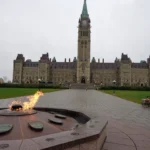During the French-Indian War and the American Revolutionary War, Fort Ticonderoga was a pivotal location. It was once known as the “Key to a Continent.” It also became an important part of American history when Ethan Allen and Benedict Arnold led the capture of the British forces and took their ammunition and artillery, which aided Americans greatly during the Revolutionary War.
Ticonderoga is derived from an Iroquois word that means “where two waters meet” or “between two waters.”
Fort Ticonderoga is located on Lake Champlain’s western shore. It provided access to Canada as well as the Hudson River. The fort’s location served as a vital link between the Colonies and the northern provinces.
Following their defeat at the Battle of Lake George in 1755, French settlers built Fort Ticonderoga in 1756. It was given the name Fort Carillon.
It was constructed on the orders of Marquis de Vaudreuil, Governor-General of New France. The fort was a 7-foot-high, 14-foot-thick wall based on the famous French engineer Sébastien Le Prestre de Vauban’s old-star-shaped design.
Despite the fort’s geometrical shape, its location and size were disadvantages. The fort could only hold 400 garrison troops and was visible from several hills.
British forces led by Maj. Gen. James Abercrombie attempted to attack the fort with over 15,000 men on July 8, 1758. He ordered a frontal assault on the French entrenchment by mistake and suffered a heavy loss.
On July 26 and 27, the following year, British Brig. Gen. Jeffrey Amherst returned with 11,000 men and defeated the French garrison with only 400 men. The British victory was extended when they captured Fort Carillon, allowing them to conquer Canada and end the Seven Years War.
Because of its small size, the newly captured fort was named Fort Ticonderoga by British forces. It eventually fell into disuse.
When fighting broke out between colonial militiamen and British soldiers in Lexington and Concord, Massachusetts, in 1775, Fort Ticonderoga had fewer than 50 men.
Benedict Arnold, a young military officer at the time, had heard that Fort Ticonderoga, which was not heavily fortified, housed a large number of British cannons and artillery.
He persuaded Cambridge’s Massachusetts Committee of Safety to lead a campaign to seize Fort Ticonderoga.
They agreed, but he could only bring 400 men from Massachusetts.
During the Seven Years’ War, Ethan Allen, a member of the Litchfield County militia, acquired land in the New Hampshire Grants. When the need arose to defend the New Hampshire Grants, he formed the Green Mountain Boys and was given command of them, naming their leader colonel commandant.
The group’s goal was to defend their land against colonial New Yorkers attempting to claim it in the Green Mountains. The New Yorkers were physically intimidated into leaving the area by the group.
Allen and his group proposed political independence for their district prior to the American Revolution. Later, it was changed to independence from Britain.
The Green Mountain Boys were formed across Lake Champlain in Vermont.
In late April, Allen received a message from an irregular Connecticut militia asking for his assistance in capturing Fort Ticonderoga. He gathered 60 men in Massachusetts and Connecticut, knowing the significance of the fort’s location.
In May 1775, Benedict Arnold and his 400 men stopped in Vermont on their way to Fort Ticonderoga. They met Allen’s group, who were also preparing for the siege, when they arrived at Hand’s Cove, two miles below Fort Ticonderoga.
Arnold, assuming he would lead the siege with the Green Mountain Boys, handed their leader a copy of his commission from the Massachusetts Committee of Safety. Allen’s men refused to accept Arnold as their leader, forcing him to step down and become second in command.
On May 10, 1775, Allan and Arnold rowed across Lake Champlain with 80 men in silence. They were able to enter the fort without firing and even surprised the sleeping guards. The group went inside, finding more British militia sleeping and surrendering without a fight, including the fort’s commandant, Captain William Delaplace.
The siege was the Thirteen Colonies’ first significant victory without having to fire anyone or spill any blood.
With the capture of Fort Ticonderoga, the Americans secured the entrance to Canada and used it as a base to take the nearby British fort of Crown Point.
The colonists also took British artillery, which helped them overcome one of their challenges in preparing for the revolutionary war.
The Red Coats surrendered to the Americans 78 cannons, six mortars, three howitzers, and a massive amount of ammunition.
George Washington directed that many of the captured guns be transported to Boston by American Colonel Henry Knox. They used them to lay siege to the town, forcing the British to flee in March 1776.
British General John Burgoyne planned an attack on Fort Ticonderoga in July 1777. Knowing the fort’s weakness, the general captured Mt. Defiance and directed artillery at it.
American General Arthur St. Clair prepared for the attack and directed his troops to hold the fort as long as possible.
He ordered his men to abandon the fort on July 6, 1777, knowing that the British would attack from the hills surrounding their garrison, risking his reputation.
However, after Burgoyne surrendered at Saratoga on October 17, the Redcoats permanently abandoned the Fort in November. They destroyed a large portion of their artillery and fortifications, rendering them useless to the Americans.
No military regiment occupied Fort Ticonderoga after the Revolutionary War. The fort served as a base of operations for scouting parties and raiding detachments. George Washington visited the ruins in 1783 while waiting for the official declaration of peace and the end of the Revolutionary War.
Stephen Pell, a history buff, restored Fort Ticonderoga and turned it into a tourist attraction in 1908.









Your blog has become my go-to destination for intellectual stimulation and personal growth. Your passion for learning shines through in every word, and your ability to ignite a sense of curiosity within your readers is awe-inspiring. Thank you for generously sharing your wealth of knowledge and for continually inspiring me to expand my boundaries.